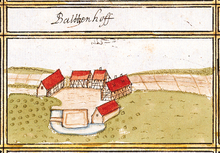Balzhof
Balzhof is a lost place in the Cleebronn district . The place once had its own location marker and also produced a noble family named after the place. From the 15th to the 18th century the court was inherited from Württemberg. Most of the buildings were demolished around 1800, only the sheep farm continued to operate there. The last building, the sheep house, was finally demolished in 1924.
history
The Balzhof was once the largest estate on today's Cleebronner mark. The farm had its own markings that included the three Zelgen Ransbacher Zelg , Mittlere Zelg and Zelg towards Eibensbach . The noble von Baltshofen family named themselves after the court, whose coat of arms shows a handled vessel in the shield and which is attested from 1279 to the 16th century. Around 1300 the Lords of Baltshofen were several witnesses on documents from the Lords of Magenheim , who owned the court until 1279, before it came as a fief to the Archbishop and Cathedral Chapter of Mainz. In the late 15th century, the court was inherited from Württemberg .
In the early 17th century, the farm gradually fell into disrepair under the owner's sons, Daniel Hannenmann. During the Thirty Years' War that followed, the farm was temporarily closed. In 1650 a Johann Eybel bought the farm, but soon left the property due to economic problems. From 1661 the farm was owned by Ludwig Trapp, who in 1675 complained that he had been cheated by the manager of the farm and that the farm had been damaged by marauding soldiers. His son Johann Bernhard Trapp also reported in 1679 about further looting by soldiers. The Kiesersche Forstlagererbuch from 1684 shows the Balttzenhoff as an estate with five buildings. The farm remained in the possession of the widow and son of Johann Bernhard Trapp for some time before Duke Eberhard Ludwig von Württemberg took possession of the property in 1706 to leave it to his wife Johanna Elisabeth . From that year there is a detailed description of buildings on the Balzhof: a house with four rooms and chambers on the lower floor, four chambers on the upper floor, a fruit floor and two cattle stalls and a sheepfold, a sheephouse with an attached sheepfold for 400 sheep and a shepherd's apartment, a large barn and a large double barn , also a courtyard with nine pigsties, two henhouses and a pigeon house. Another residential building, probably the fifth building still visible on Kieser's drawing from 1684, had meanwhile burned down; its remains had been used to repair the remaining buildings. At that time, around 400 acres of land belonged to the Balzhof, of which fields (337 acres) and meadows (45 acres) made up the largest proportion, while there were only small areas with tree gardens, vineyards and forest. The wine of the Balzhof was of poor quality, so that as early as 1706 the conversion of the vineyards into fields was recommended.
After Duchess Johanna Elisabeth, her granddaughter Louise Friederike, the wife of Duke Friedrich von Mecklenburg-Schwerin , owned the farm before the Kirchheim butcher Christoph Braun acquired the property in 1760. After a few more changes of ownership in the following years, the Württemberg Rentkammer allowed the estate to be sold from the Württemberg hereditary estate in 1787. The caretaker's house in danger of collapsing and the barns were demolished, the two barns were rebuilt in Alt-Cleebronn. Only the sheep house remained of the farm. The associated usable areas were divided into 30 plots. The nearby town of Cleebronn was then divided into the two communities Alt-Cleebronn and Neu-Cleebronn, whereby the Alt-Cleebronn had only a small amount of arable land on their markings, so that 22 of the 30 parcels fell to Alt-Cleebronn, the rest to Neu- Cleebronn. The 30 parcels were further parceled out during the 19th century.
Sheep farm continued to operate on the Balzhof after 1800, whereby the owners of the Balzhof shares were allowed to keep a total of 750 sheep, one third of which could graze on the associated markings, while the remaining two thirds were driven to markings in the surrounding areas according to a precisely defined plan were. In 1870 the Cleebronn community acquired the Balzhofweide. In 1924 the sheep house, which was meanwhile also in danger of collapsing, was sold for demolition.
literature
- Wolfram Angerbauer : 700 years of Cleebronn 1279–1979. History of a community . Cleebronn municipal administration, Cleebronn 1979
